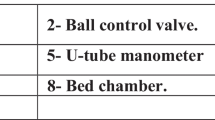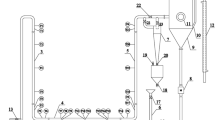Abstract
Most correlations presented for the heat transfer coefficient of liquid–solid fluidized bed heat exchangers are based on experiments with glass bead particles in particulate fluidization which usually under-predict the heat transfer coefficient. The present study used experimental data from previous studies for the heat transfer coefficient in liquid–solid fluidized bed heating systems using cylindrical metal particles and five heat transfer correlations based on experiments with spherical glass beads to approximate the behavior of the cylindrical metal particles under aggregative conditions. The results show that modifying the correlations significantly improved the prediction of heat transfer coefficients and the average relative error decreased in comparison with those for the original correlations.












Similar content being viewed by others
Abbreviations
- Ar:
-
Archimedes number
- Cpl :
-
Liquid heat capacity
- Cps :
-
Particle heat capacity
- d:
-
Diameter
- deq :
-
Equivalent diameter
- deff :
-
Effective diameter
- dp :
-
Particle diameter
- D:
-
Fluidized bed diameter
- Dh :
-
Hydraulic diameter of fluidized bed
- Nup :
-
Nusselt number based on particle diameter
- Pr:
-
Prandtle number
- Rep :
-
Particle Reynolds number
- Re +h :
-
Modified Reynolds number \(= (ud_{p} /\varepsilon \nu ).\left( {2\pi^{2} \varepsilon^{2} /\left( {1 - \varepsilon } \right)^{2} } \right)^{1/3}\)
- u:
-
Velocity
- us :
-
Superficial velocity
- umf :
-
Minimum fluid velocity
- ut :
-
Particle terminal velocity
- Vf :
-
Fluid volume
- Vs :
-
Particle volume
- \(\alpha\) :
-
Heat transfer coefficient
- \(\varepsilon\) :
-
Bed voidage
- \(\lambda_{l}\) :
-
Liquid thermal conductivity
- \(\lambda_{s}\) :
-
Particle thermal conductivity
- \(\rho_{l}\) :
-
Liquid density
- \(\rho_{s}\) :
-
Solid density
- \(\nu\) :
-
Kinematic viscosity
References
Pork P, Infante Ferreira CA, Witkamp GJ (2009) Prevention of fouling and scaling in stationary and circulating liquid-solid fluidized bed heat exchanger: Particle impact measurements and analysis. Int J Heat Mass Transf 52:3857–3868
Pork P, Infante Ferreira CA, Witkamp GJ (2010) Mitigation of ice crystallization fouling in stationary and circulating liquid-solid fluidized bed heat exchangers. Int J Heat Mass Transf 53:403–411
Jamialahmadi M, Muller SH (2007) Heat exchanger fouling and cleaning in the dehydrate process for the production of phosphoric Acid. Chem Eng Res Des 85(2):245–255
Klaren GD, Eric de Boer F (2005) Compact self-cleaning fluidized bed heat exchangers with EM baffles. Engineering Conferences International Symposium Series, 2
Xiaokai X, Chongfang M, Yongchang C (2005) Mechanism of calcium carbonate scale depositition under sub cooled flow boiling conditions. Chin J Chem Eng 13(4):464–470
Helalizade A, Muller SH, Jamalahmadi M (2003) Crystallization fouling of mixed salts during convective heat transfer and sub cooled flow boiling conditions. Engineering Conferences International, RP1
Fahiminia F, Watkinson AP, Epstein N (2003) Investigation of initial fouling rates of calcium sulfate solutions under non-boiling conditions. Engineering Conferences International Symposium Series, Digital Archives
Haid M (1997) Correlations for the prediction of heat transfer to liquid-solid fluidized beds. Chem Eng Process 36(2):143–147
Jamialahmadi M, Malayeri MR, Muller SH (1995) Predication of heat transfer to liquid- solid fluidized beds. Can J Chem Eng 73(4):444–455
Jamialahmadi M, Malayeri MR, Muller SH (1996) A unified correlation for the predication of heat transfer coefficient liquid-solid fluidized bed systems. J Heat Transfer 118(4):952–959. doi:10.1115/1.2822594
Haid M, Martin H, Müller SH (1994) Heat transfer to liquid–solid fluidized beds. Chem Eng Process 33(4):211–225
Yang Wen-Ching (2003) Hand book of fluidization and fluid-particle systems. Marcel Decker, New York
Aghajani M, Muller-Steinhagen H, Jamialahmadi M (2004) Experimental results and models for solid/liquid fluidized beds involving newtonian and non-newtonian liquids. Dev Chem Eng Miner Process 12(3/4):403–426
Klaren GD, Eric de Boer F (2004) Case study involving severely fouling heat transfer: design and operating experience of a self-cleaning fluidized bed heat exchanger and its comparison with the newly developed compact self-cleaning fluidized bed heat exchanger with EM baffles. Presented at the Fachveranstaltung: Verminderung der Ablagerungsbildung an Warmeubertragerflachen, Bad Durkheim, Germany, October 2004
Richardson JF, Romani MN, Shakiri KJ (1976) Heat transfer from immersed surfaces in liquid fluidized beds. Chem Eng Sci 31(8):619–624
Wallis GB (1969) One-dimensional waves in two-component flow (with particular reference to the stability of fluidized beds). United Kingdom Atomic energy Authority Report, AEEW-R 162, Harwell, UK
Slis PL, Willemes ThW, Kramers H (1959) The response of the level of a liquid fluidized bed to a sudden change in the fluidizing velocity. Appl Sci Res A 8(1):209–218
Richardson JF, Zaki WN (1954) Sedimentation and fluidization: part I. Trans Inst Chem Eng 32:35–53
Foscolo PU, Gibilaro LG (1984) A fully predictive criterion for the transition between particulate and aggregate fluidization. Chem Eng Sci 39:1667–1675
Gibilaro LG, Hussein I, Foscolo PU (1986) Aggregative behavior of liquid fluidized beds. Can J Chem Eng 64:931–938
Aghajani M, Muller-Steinhagen H, Jamialahmadi M (2004) Heat transfer of liquid/solid fluidized bed for newtonian and non-newtonian fluids. Iran J Chem Chem Eng 23(1):119–130
Jamialahmadi M, Muller SH (2000) Hydrodynamics and heat transfer of liquid fluidized bed system. Chem Eng Commun 179(1):35–79
Kang Y, Fan LT, Kim SD (1991) Immersed heater-to-bed heat transfer in liquid-solid fluidized beds. AIChE J 37(7):1101–1106
Aghajani M, Muller-Steinhagen H, Jamialahmadi M (2005) New design equation for liquid/solid fluidized bed heat exchangers. Int J Heat Mass Transf 48:317–329
Author information
Authors and Affiliations
Corresponding author
Rights and permissions
About this article
Cite this article
Maddahi, M.H., Hatamipour, M.S. & Jamialahmadi, M. Modification of heat transfer correlations in a liquid–solid fluidized bed heat exchanger with cylindrical particles in aggregative fluidization. Heat Mass Transfer 52, 2391–2400 (2016). https://doi.org/10.1007/s00231-015-1747-4
Received:
Accepted:
Published:
Issue Date:
DOI: https://doi.org/10.1007/s00231-015-1747-4




